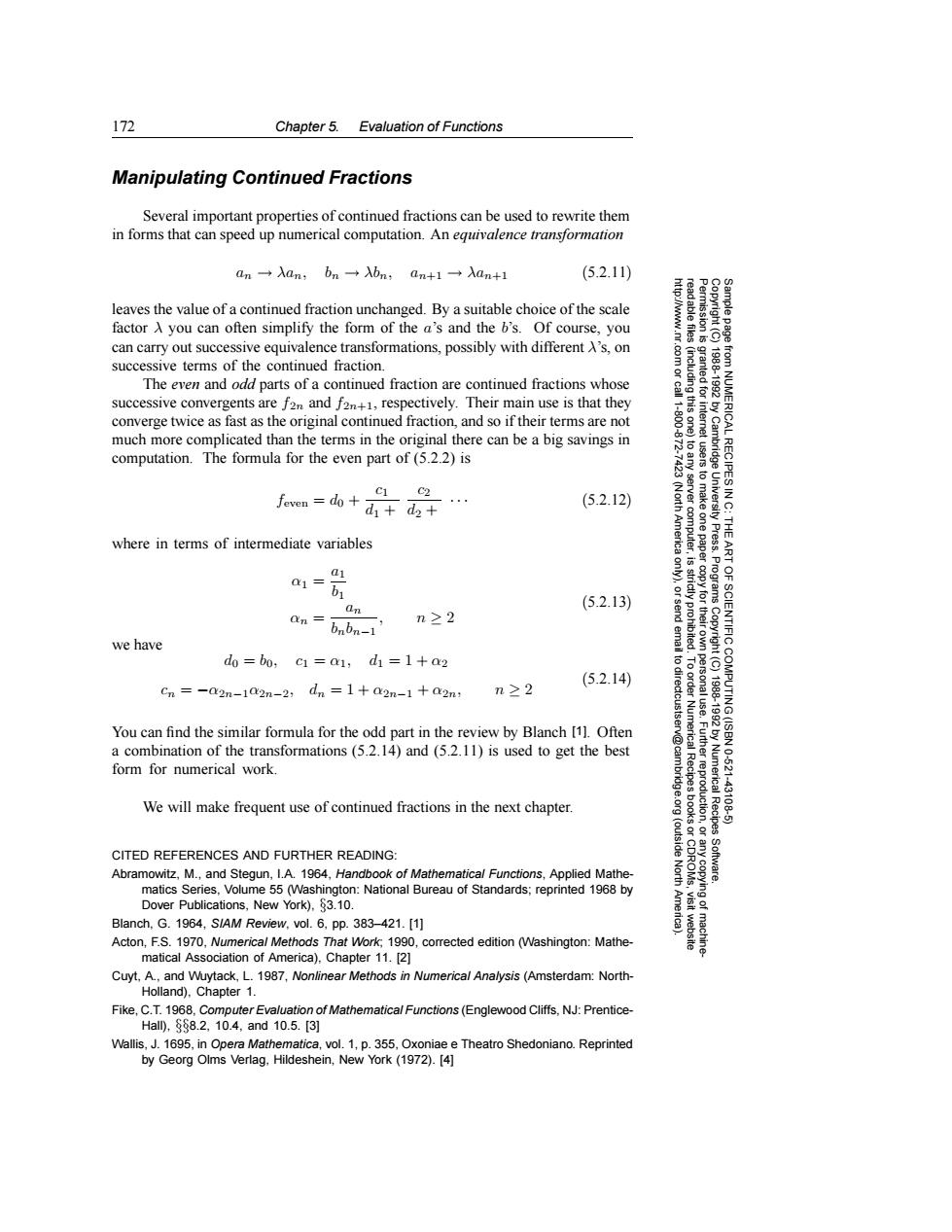正在加载图片...

172 Chapter 5.Evaluation of Functions Manipulating Continued Fractions Several important properties of continued fractions can be used to rewrite them in forms that can speed up numerical computation.An equivalence transformation an→an,bn→λbn:an+1一λan+1 (5.2.11) leaves the value of a continued fraction unchanged.By a suitable choice of the scale factor A you can often simplify the form of the a's and the b's.Of course,you can carry out successive equivalence transformations,possibly with different A's,on successive terms of the continued fraction. The even and odd parts of a continued fraction are continued fractions whose 菲 successive convergents are f2n and f2n+1,respectively.Their main use is that they converge twice as fast as the original continued fraction,and so if their terms are not much more complicated than the terms in the original there can be a big savings in computation.The formula for the even part of(5.2.2)is RECIPESI feven=dodd+ C1 C2 (5.2.12) where in terms of intermediate variables Press. b1 (5.2.13) 三兰。 an=bnbn-1 n≥2 we have d0=b0,c=a1,d1=1+a2 Cn=-a2n-1a2m-2,dn=1+a2m-1+a2m: n≥2 (5.2.14) You can find the similar formula for the odd part in the review by Blanch [1].Often x a combination of the transformations(5.2.14)and(5.2.11)is used to get the best form for numerical work. Numerical We will make frequent use of continued fractions in the next chapter. 经”> -431 CITED REFERENCES AND FURTHER READING: (outside Recipes Abramowitz,M.,and Stegun,I.A.1964,Handbook of Mathematical Functions,Applied Mathe- North matics Series,Volume 55 (Washington:National Bureau of Standards;reprinted 1968 by Dover Publications,New York),83.10. Blanch,G.1964,S/AM Review,vol.6,pp.383-421.[1] Acton,F.S.1970,Numerica/Methods That Work,1990,corrected edition (Washington:Mathe- matical Association of America),Chapter 11.[2] Cuyt,A.,and Wuytack,L.1987,Nonlinear Methods in Numerical Analysis (Amsterdam:North- Holland),Chapter 1. Fike,C.T.1968,Computer Evaluation of Mathematical Functions(Englewood Cliffs,NJ:Prentice- Hall,ss8.2,10.4,and10.5.[3] Wallis,J.1695,in Opera Mathematica,vol.1,p.355.Oxoniae e Theatro Shedoniano.Reprinted by Georg Olms Verlag,Hildeshein,New York(1972).[4]172 Chapter 5. Evaluation of Functions Permission is granted for internet users to make one paper copy for their own personal use. Further reproduction, or any copyin Copyright (C) 1988-1992 by Cambridge University Press. Programs Copyright (C) 1988-1992 by Numerical Recipes Software. Sample page from NUMERICAL RECIPES IN C: THE ART OF SCIENTIFIC COMPUTING (ISBN 0-521-43108-5) g of machinereadable files (including this one) to any server computer, is strictly prohibited. To order Numerical Recipes books or CDROMs, visit website http://www.nr.com or call 1-800-872-7423 (North America only), or send email to directcustserv@cambridge.org (outside North America). Manipulating Continued Fractions Several important properties of continued fractions can be used to rewrite them in forms that can speed up numerical computation. An equivalence transformation an → λan, bn → λbn, an+1 → λan+1 (5.2.11) leaves the value of a continued fraction unchanged. By a suitable choice of the scale factor λ you can often simplify the form of the a’s and the b’s. Of course, you can carry out successive equivalence transformations, possibly with different λ’s, on successive terms of the continued fraction. The even and odd parts of a continued fraction are continued fractions whose successive convergents are f2n and f2n+1, respectively. Their main use is that they converge twice as fast as the original continued fraction, and so if their terms are not much more complicated than the terms in the original there can be a big savings in computation. The formula for the even part of (5.2.2) is feven = d0 + c1 d1 + c2 d2 + ··· (5.2.12) where in terms of intermediate variables α1 = a1 b1 αn = an bnbn−1 , n ≥ 2 (5.2.13) we have d0 = b0, c1 = α1, d1 =1+ α2 cn = −α2n−1α2n−2, dn =1+ α2n−1 + α2n, n ≥ 2 (5.2.14) You can find the similar formula for the odd part in the review by Blanch [1]. Often a combination of the transformations (5.2.14) and (5.2.11) is used to get the best form for numerical work. We will make frequent use of continued fractions in the next chapter. CITED REFERENCES AND FURTHER READING: Abramowitz, M., and Stegun, I.A. 1964, Handbook of Mathematical Functions, Applied Mathematics Series, Volume 55 (Washington: National Bureau of Standards; reprinted 1968 by Dover Publications, New York), §3.10. Blanch, G. 1964, SIAM Review, vol. 6, pp. 383–421. [1] Acton, F.S. 1970, Numerical Methods That Work; 1990, corrected edition (Washington: Mathematical Association of America), Chapter 11. [2] Cuyt, A., and Wuytack, L. 1987, Nonlinear Methods in Numerical Analysis (Amsterdam: NorthHolland), Chapter 1. Fike, C.T. 1968, Computer Evaluation of Mathematical Functions (Englewood Cliffs, NJ: PrenticeHall), §§8.2, 10.4, and 10.5. [3] Wallis, J. 1695, in Opera Mathematica, vol. 1, p. 355, Oxoniae e Theatro Shedoniano. Reprinted by Georg Olms Verlag, Hildeshein, New York (1972). [4]